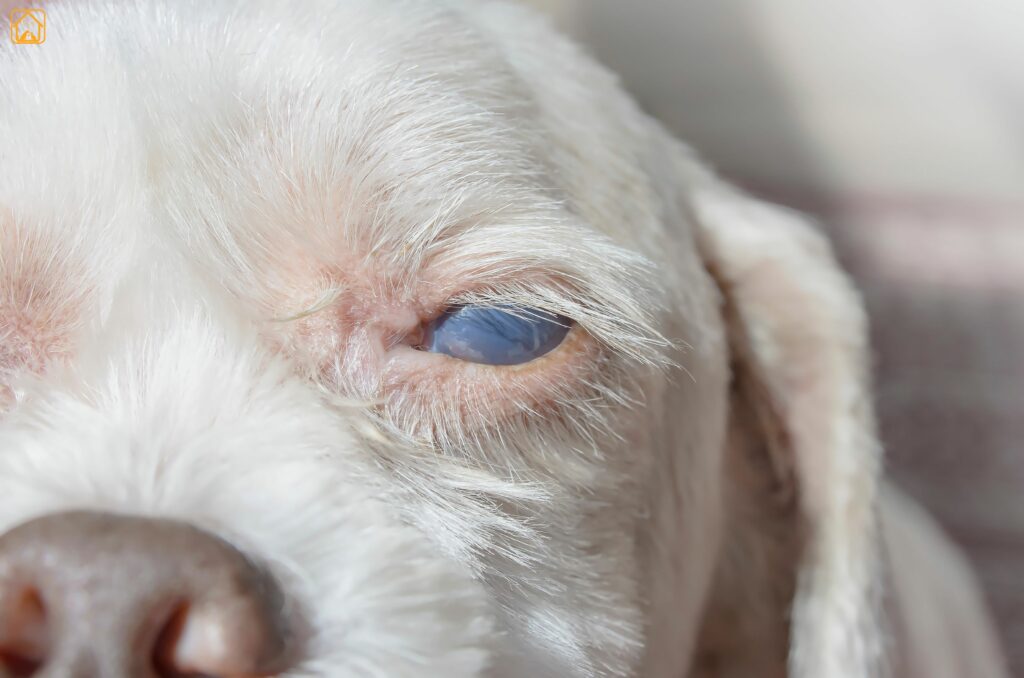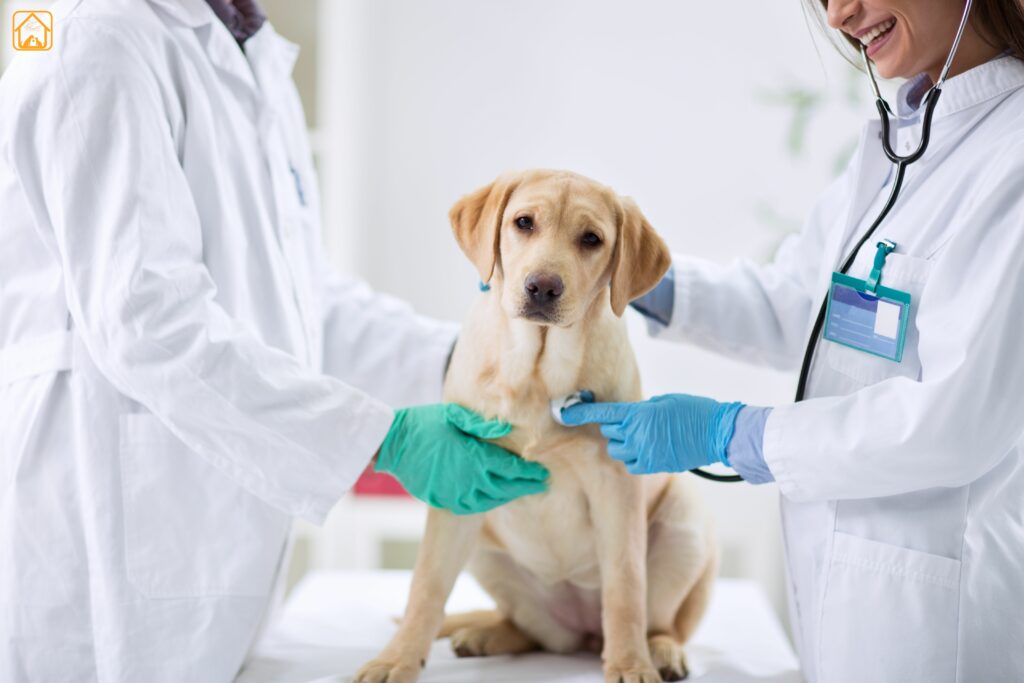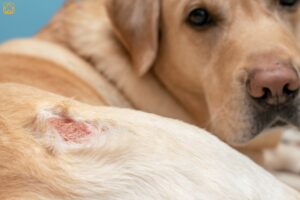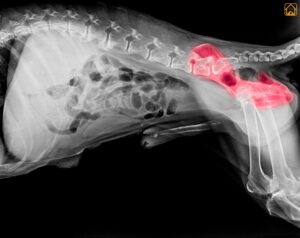Overview of Labrador Retriever Health
Labrador Retrievers nature and gentle temperament make them one of the world’s favorite family dogs. But behind those soulful eyes and wagging tails, Labradors can be prone to specific health concerns, and being aware of common Labrador health issues helps dog parents understand the problems early.
The most common health issues in Labrador Retrievers include joint problems like hip and elbow dysplasia, skin conditions, ear infections, eye diseases, hormonal disorders, obesity, and even some forms of cancer. Labs are also prone to tummy troubles and may develop bloat or other digestive issues.
Joint and Mobility Issues in Labradors (Hip & Elbow Dysplasia, Arthritis)

Understanding Joint Health in Labs
Joint problems are at the top of the list when it comes to Labrador health issues, especially as your dog ages. Hip dysplasia and elbow dysplasia are both inherited conditions where the joints don’t form correctly, leading to pain and, over time, arthritis. If you’ve ever seen your Lab hesitate before climbing stairs or struggle to get up after a nap, joint pain could be the culprit.
- Hip Dysplasia: This is a biggie. The hip joint where the ball and socket don’t fit together properly, causing pain, stiffness, and eventually arthritis. Symptoms might be subtle (a little reluctance to jump) or obvious (limping, trouble standing, or a weird “bunny hop” run). It often shows up as your Lab gets older, but some puppies show signs early. Vets diagnose it with X-rays, and treatment ranges from weight management and supplements to surgery in severe cases.
- Elbow Dysplasia: Another common joint issue in Labs, elbow dysplasia leads to forelimb lameness and pain. Watch for limping, swelling, or your Lab avoiding putting weight on a front leg. Like hips, elbows should be tested in breeding dogs to minimize passing on this problem.
I remember my own Lab, Bunny, started skipping her favorite fetch sessions. At first, I thought he was just tired, but it turned out his hips were bothering him. Early intervention and regular checkups made all the difference.
- Arthritis: Over time, both dysplasias lead to arthritis, a painful, degenerative joint disease. Senior Labradors are especially at risk.
- Cruciate Ligament Tears: Labs are also prone to ligament injuries (like cranial cruciate ligament tears), especially if they’re super active or overweight. Obesity is one of the biggest risk factors for joint issues, extra pounds put a huge strain on those happy Lab legs.
| Joint Issue | Common Signs | Prevention/Treatment |
| Hip Dysplasia | Limping, stiffness, bunny hop gait | Weight control, supplements, surgery |
| Elbow Dysplasia | Front leg lameness, swelling, pain | Physical therapy, medication, surgery |
| Arthritis | Stiffness, difficulty rising, reluctance to exercise | Joint care, anti-inflammatories, lifestyle changes |
| Cruciate Ligament Tears | Sudden limping, favoring a back leg | Rest, surgery, rehab |
What can you do to help your Lab’s joints? Here are some quick wins:
- Feed a balanced, healthy food for Labrador dogs and watch portion sizes
- Keep exercise consistent but low-impact (think walks and swimming over jumping or rough play)
- Consider joint supplements like glucosamine and chondroitin (talk to your vet first)
- Schedule regular vet check-ups and joint assessments
- Use ramps or stairs to help your Lab get in cars or on furniture if needed
Labrador retriever joint care isn’t just about medication, it’s about a total lifestyle approach. With early detection and thoughtful daily routines, your Lab can keep those tail wags and zoomies going strong, even into their senior years. If you’re concerned about specific conditions like hip problems in dogs which are especially common in Labs, early awareness is key.
“Think of your Lab’s care as proactive, not reactive. Annual exams, a healthy weight, and prompt attention to changes are the best medicines for a long, tail-wagging life.” – Dr. Laura Bennett, DVM
While joint care is a big part of keeping your Lab healthy, skin and ear issues are another major category of Labrador health issues that can affect their daily comfort.
Labrador Skin and Ear Conditions: Allergies, Infections, and Care

Ever noticed your Lab scratching, shaking their head, or random bald patches? One of the most common health problems in Labs is skin trouble, and it can drive both dogs and owners a little crazy.
Common Skin and Ear Issues in Labs
Labrador skin issues often boil down to three main culprits: allergies, infections, and underlying hormonal problems.
- Allergies: Allergies in Labrador Retrievers are fairly common and can be caused by both environmental and food triggers. Grass, pollen, dust mites, or certain proteins in food can lead to red, itchy skin, constant licking, and even ear infections. Common signs include chewing on paws, rubbing their face, and recurring hot spots.
- Hot Spots & Dermatitis: These are inflamed patches that may ooze or smell bad. Hot spots pop up fast, one minute your Lab is fine, the next they’re gnawing at a raw spot. Wet fur and thick coats make Labs more likely to get them.
- Ear Infections: Labs are magnets for yeast and bacterial infections. Symptoms are like head shaking, odor, redness, and scratching. Keep those ears clean and dry, especially after a bath or swim.
- Hormonal Skin Conditions: Hypothyroidism (low thyroid hormone) or Cushing’s disease can cause flaky skin, hair loss, and recurring infections. If your Lab’s coat suddenly looks dull or patchy, ask your vet about blood tests.
What about labrador retriever skin conditions that look like tiny bumps, lumps, or warts? Labs can develop both benign and malignant skin tumors, including mast cell tumors. Any new lump or persistent sore should get checked right away, better safe than sorry.
Quick skin care tips for Labrador parents:
- Brush your Lab regularly to remove loose hair and spot skin changes early
- Use vet-approved shampoos for sensitive or allergy-prone skin
- Dry ears and fur thoroughly after swimming or bathing
- Keep up with flea and tick prevention
- Feed high-quality, balanced nutrition to support healthy skin
Proactive care makes a difference. Daily ear checks and regularly grooming your labrador help keep these problems in check. You know what’s weird? I once caught a skin infection on my Bunny just because she kept rolling on her back, it was her way of asking for help!
Eye Problems in Labradors: Cataracts, PRA, and More

Eye problems in Labs are more common than many think. Cataracts, Progressive Retinal Atrophy (PRA), and retinal dysplasia can cause vision loss or even blindness. Labs can also get hereditary cataracts as puppies or adults.
Eye Problems in Labradors
- Cataracts: These cause a cloudy or bluish haze in the eye and can show up even in young Labs. Some cataracts are mild, but others may lead to vision loss.
- Progressive Retinal Atrophy (PRA): This genetic disease slowly causes blindness. One of the first signs is night blindness or bumping into things in dim light.
- Retinal Dysplasia: An inherited issue that disrupts normal eye development and may cause vision problems early on.
- Entropion: A condition where the eyelid rolls inward, irritating the eye (ouch!). You might see squinting or tearing.
With regular check-ups and health screening, many labrador eye issues can be managed, or even prevented through responsible breeding. If you notice squinting, excessive tearing, cloudy eyes, or your Lab acting unsure in low light, don’t wait. Early intervention is everything.
Ear Problems in Labradors
Now, let’s talk about the ears. Those velvety, floppy ears are adorable, but they’re also a perfect hideout for moisture, yeast, and bacteria. Here’s what to watch for:
- Ear Infections: Redness, itchiness, head shaking, or a funky smell often signal trouble. Labs love water, so drying ears thoroughly after swimming or bathing is key.
- Chronic Otitis: Recurring ear infections can lead to thickened ear canals and hearing loss if left untreated.
- Ear Mites: Less common, but still possible, especially in puppies. You’ll see dark debris and lots of scratching.
Regular cleaning (with a vet-approved solution) and keeping those ears dry can help prevent many labrador retriever ear problems. Never stick cotton swabs deep in the ear canal, just a gentle wipe around the outer ear works wonders.
Hormonal and Metabolic Disorders: Hypothyroidism, Cushing’s, and Diabetes
Recognizing Hormonal Health Problems
Labrador health issues aren’t just on the outside. Inside, hormone imbalances can cause big changes. Hypothyroidism is a common problem in Labs, where the thyroid gland doesn’t produce enough hormones. Symptoms are weight gain, sluggishness, and coat changes. Sometimes, Labs develop Cushing’s disease (too much cortisol) or diabetes (problems with blood sugar).
- Hypothyroidism: Look for weight gain, hair loss, and low energy.
- Cushing’s Disease: Symptoms include increased thirst, urination, and a pot-bellied appearance.
- Diabetes: Watch for excessive drinking, urination, sudden weight loss, or lethargy.
Blood tests are crucial for diagnosis. Trust your gut, if your Lab just isn’t acting like themselves, ask your vet for a checkup. I once thought my dog was just “getting older,” when it was really a thyroid issue. A simple pill turned things around.
Obesity and Weight Management: Healthy Weight for a Labrador

Obesity in dogs is one of the most common health problems in Labradors. Labs love food, and those pleading eyes make it tough to resist handing out extra treats. But those extra treats lead to extra pounds and that leads to even more health issues for Labrador Retrievers, like joint pain, diabetes, and heart disease.
- Feed a high-quality, portion-controlled diet. Ask your vet about the healthy weight for a Labrador based on size, age, and activity.
- Avoid table scraps and calorie-dense treats.
- Daily walks and fetch sessions help burn calories and keep minds sharp.
If you can’t easily feel your Lab’s ribs, it might be time to reassess their diet. I used to keep a “treat jar” on the counter, now, it’s a “carrot jar.” My Lab still begs, but now she’s healthy.
Labrador Stomach and Digestive Issues (Bloat, Stomach Problems)
Digestive health is a real concern for Labs. Bloat (gastric dilatation-volvulus) is a serious, life-threatening issue in deep-chested breeds like Labradors. Other stomach problems include food sensitivities and chronic diarrhea.
- Bloat: Can strike fast. Signs include a swollen belly, restlessness, drooling, and attempts to vomit with no result. This is an emergency, get to the vet right away.
- Stomach Sensitivities: A condition where their stomach gets easily upset by certain foods, causing symptoms like vomiting, diarrhea, or too much gas.
Feed multiple small meals, avoid vigorous exercise after eating, and stick to a routine diet. One evening, my Lab started pacing and drooling, I panicked, called the vet, and it probably saved her life. Trust your instincts.
Cancer and Other Serious Health Concerns in Labradors
Labs can be prone to both benign and malignant tumors, including mast cell tumors, hemangiosarcoma (often affecting the spleen), and lymphosarcoma. Early signs might be subtle, like lumps under the skin, lethargy, or unexplained weight loss. Labs also face increased risk of heart and kidney disease as they age.
- Check for new lumps or bumps during regular grooming.
- Watch for changes in appetite, behavior, or bathroom habits.
- Annual wellness exams help catch problems early.
It’s always a shock to find something serious, but prompt action really can make a difference. I know more than one Lab owner who caught a tumor early during a routine belly rub.
Health Testing, Early Detection, and Preventive Care for Labradors
Why Screening Matters
With so many common health issues with Labradors, preventive care is your best defense. Responsible breeders screen for hip and elbow dysplasia, eye conditions, and some inherited diseases. Ask for health certificates when choosing a puppy. For adult Labs, regular vet visits, annual bloodwork, and screenings help detect problems before they escalate.
- Key health tests: Hip and elbow scoring, eye exams, thyroid testing, and genetic screening.
- Regular checkups for heart, kidney, and metabolic function.
- Vaccinations, dental care, and parasite control round out a healthy routine.
Ever had a moment where you almost skipped a vet visit because “everything seems fine”? I have, and caught a tick fever before it became a bigger issue. Prevention is so much easier than treatment.
Diet, Exercise, and Lifestyle Tips for Labrador Health
Keeping your Labrador healthy isn’t just about treating problems, it’s about building good habits. Feed your Lab a balanced, high-quality diet, tailored to age and activity. Exercise daily, but adapt activities for Labs with joint issues. Swimming is a fantastic low-impact workout.
- Stick to a consistent feeding schedule with healthy food for Labrador dogs.
- Regular exercise keeps joints limber and minds active, think walks, games, and swimming.
- Keep up with grooming, especially ear cleaning and nail trims.
- Enrich your Lab’s environment with toys and training to prevent behavior problems.
Honestly, the best advice I ever got? “Keep your Lab lean and moving.” It’s simple, but it works every time.
FAQs About Labrador Health Issues
What are the most common health issues for Labrador Retrievers?
Labradors often face joint problems (like hip and elbow dysplasia), skin allergies, ear infections, eye diseases (like PRA and cataracts), obesity, and some cancers. Early detection and preventive care help manage these risks.
How do I know if my Lab has hip or elbow dysplasia?
Watch for signs like limping, stiffness, trouble rising, or reluctance to play. An early vet check and X-rays can confirm a diagnosis. Ask breeders about health testing on parents before adopting.
What’s the healthy weight for a Labrador?
It varies, but most adult Labs should weigh between 55 and 80 pounds. Your vet can help determine the ideal healthy weight for a Labrador based on their build and lifestyle.
How can I prevent ear infections in my Lab?
Dry their ears after swimming or bathing, clean regularly, and check for redness or odor. Floppy ears trap moisture, so prevention is key.
Are skin problems in Labs always allergies?
No, while allergies are common, skin issues can also stem from infections, hormonal imbalances, or even tumors. Persistent scratching or hair loss? Get it checked by a vet.
What should I feed my Labrador to support health?
Choose a high-quality, balanced diet with the right calories for age and activity. Avoid overfeeding, and use healthy treats like carrots or green beans. Consult your vet for specific recommendations.
How often should Labradors see the vet?
At least once a year for a wellness exam, or more often for seniors or dogs with ongoing health issues. Regular visits help catch problems early and keep vaccinations up to date.
Conclusion
Labrador Retrievers are generally healthy, active dogs, but like all breeds, they’re prone to certain health issues. From joint problems and obesity to allergies and ear infections, staying informed helps you catch early signs and keep your Lab feeling their best. Regular vet checkups, a balanced diet, exercise, and good grooming habits go a long way in preventing many common problems.
By staying informed about potential Labrador health issues, you’ll be better equipped to make proactive choices for your dog’s wellbeing.



